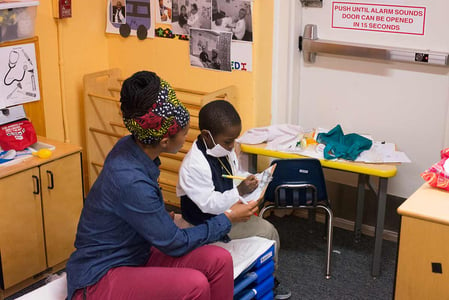
Are you an educator who recently had a CLASS® observer come to your classroom? Maybe the observer mentioned something about giving you your CLASS scores—or maybe you aren’t sure when or how you’ll get feedback from the observation. If that recently happened to you, you might have typed something into Google like, “What are CLASS scores?” Not to fear. I hope this blog post clears it up for you!
First, you should know that “CLASS” is an acronym that stands for the CLassroom Assessment Scoring System. It’s an observational measure that looks at the interactions between educators and children. These interactions are categorized into three domains (if you work with pre-K through 12th-grade students): Emotional Support, Classroom Organization, and Instructional Support. Each of these domains is further made up of dimensions, and those dimensions describe specific behavioral indicators.
Researchers at the University of Virginia developed CLASS in 2008 to help educators improve what matters most in the classroom—the interactions that drive learning and development. Since then, over 150 research studies have proven that children in classrooms with high CLASS scores have better academic and social outcomes.
You might have heard others talking about “getting all 7s,” or trying to “get a 6” in a specific dimension. That’s because each of the CLASS dimensions are scored on a scale of 1-7. A score of 1 means that there were little-to-no indicators of this type of interaction during the 20-minute observation cycle.
What do CLASS scores mean for educators?
Organizations aren’t conducting CLASS observations as a punitive measure. In fact, 60% of programs* are using CLASS scores to inform their professional development program. This means that an instructional coach or mentor sees the observer’s score sheet and notes, and then your coach will give feedback based on this data.
One good thing about CLASS scores is that the control to improve your scores is in your control. Unlike other assessments that are based on the size of your playground, number of books, or other aspects that are out of your control (and budget), you can always improve your own interactions. Your administrator or coach will teach you about the importance of different kinds of interactions and offer you strategies to strengthen your relationship with the children in your classroom.
Another pro to being assessed with CLASS is that the tool can work with any curriculum or education setting. It can be applied in a family child care setting as easily as it can in a public Head Start program, a private child care center, or in K-12. You can also use the CLASS tool alongside another assessment system. Over 60% of programs* use CLASS along with the Environmental Ratings Scales (ERS). Learn more about using CLASS and other assessments and curriculums here.
Will I get to see my scores?
That’s a great question—and to be totally honest—every program handles observation scores differently. Sometimes, educators will get to see their scores for each CLASS dimension and will be allowed to choose which dimension they’d like to spend time focusing on. In other programs, coaches will share the range of an educator’s scores. For example, you might see that you got a “low-range” in Productivity meaning that you scored a 1, 2, or 3—but you will not see which number was assigned to that CLASS dimension. In these two scenarios, educators might get their feedback either as a written report or through a conversation with a superior.
Still, other programs prefer to not share any specific CLASS data with their teachers at all. Instead, coaches in these organizations may use the data to provide personalized support for teachers.
And finally, only 16% of educators have received no feedback at all after having their classroom observed. In these instances, it’s likely that these programs are conducting CLASS observations as a method of monitoring at the state or federal level. Teachstone strongly suggests that even programs that are required to take part in CLASS observations should couple their observations with CLASS-based professional development.
What should I expect?
Here’s what Dara said about the observation that was conducted in her pre-K classroom:
If you have any additional questions about the CLASS tool, your scores, or how your program is using CLASS, reach out to your school administrator or coach. If you’re interested in learning more about how interactions impact children, consider taking our Introduction to the CLASS Tool course or reading through our CLASS Dimensions Guide. Or, give us a call at 866-998-8352.
*Data from the 2015 State of CLASS.
